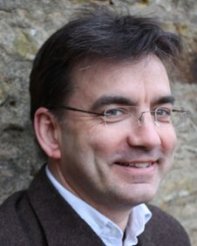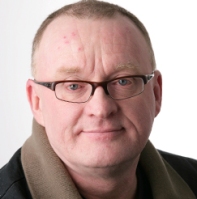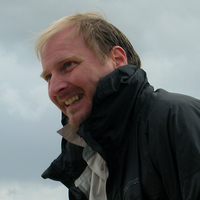Prof. Tom Inns
Professor Inns was appointed Director of The Glasgow School of Art in September 2013. He was previously Dean of Duncan of Jordanstone College of Art & Design (DJCAD) and Director of Research for the College of Art Science & Engineering at the University of Dundee.
Tom studied Engineering at Bristol University and Industrial Design Engineering at the Royal College of Art. In 1990 he was a co-founder of the Design Research Centre at Brunel University, becoming Director in 1996. He completed his PhD in 1998 and moved to DJCAD as Professor of Design in 2000 becoming Head of the School of Design in 2001, where he established new undergraduate and postgraduate programmes linking curriculum in design and fine art with computing, engineering, medicine and the humanities.
In 2004 he was appointed as Director of the UK Research Council funded, Designing for the 21st Century Research Initiative. Over a five-year period he led this £6.5 million initiative co-ordinating the work of 41 research projects, linking design to disciplines in science and engineering in universities across the UK. In 2010 he was appointed Dean of DJCAD. He has a strong interest in the future of design and how design thinking can facilitate interdisciplinary discussions. He teaches strategic design at the Universities of Dundee and St Andrews and regularly designs and facilitates knowledge sharing events and workshops with research organisations and innovation agencies across Europe.
Tom Inns’ Blog
Profile on GSA website
Prof. Christopher Platt
Christopher Platt is Head and Professor of Architecture at the Mackintosh School of Architecture, Glasgow, and one of the founding directors of studioKAP architects (www.studioKAP.com) .He is a registered architect in Great Britain and was previously a member of the Architektenkammer in Berlin. He is a Fellow of the Higher Education Academy and was made a Fellow of the Royal Incorporation of Architects of Scotland in 2009. He is involved in both practice-based research and research-driven practice and writes on a wide range of issues overlapping practice and academia. He was apprentice, student and design tutor at the Mackintosh School of Architecture, Glasgow, under Professors Andy MacMillan and Isi Metzstein.
studioKAP website
Profile on GSA website
Stuart Cosgrove
Stuart Cosgrove is Director of Creative Diversity at UK television corporation, Channel 4. He joined the channel in April 1995 and, as the controller of arts and entertainments, he was responsible for managing arts and entertainment, sports and Channel 4’s flagship American programmes, such as ER, Friends & Frasier.
Currently, he oversees relationships within the independent production community and programmes commissioned outside of London.
Born in Perth, Scotland, he graduated in Drama and English at the University of Hull, and has a PhD in Media.
Stuart lives in Glasgow where he also works as a broadcaster and commentator.
Kate Davidson is Honorary Professor of Clinical Psychology at the University of Glasgow. She is a Fellow of the British Psychological Society and Honorary Fellow of BABCP. Her previous Health Service post in the NHS in Scotland was Director of the Glasgow Institute of Psychosocial Interventions. She was also Director of the South of Scotland CBT course for over 20 years. She now works as Editor of an academic journal, CBT trainer and as a practitioner.
Ranald McInnes
Ranald MacInnes is Head of Heritage Management at Historic Scotland with responsibilities which include advising the Scottish Government on planning and historic environment issues. He began his career with English Heritage in the 1980s. He has a special interest in 20th-century architecture and planning. He is an Honorary Research Fellow of the Institute of Art History, University of Glasgow, Visiting Lecturer in Architectural Design for the Conservation of Built Heritage at the University of Strathclyde and has taught conservation at the Mackintosh School of Architecture. He has published many books, essays, articles and reviews on architectural history and conservation. He has played a leading research-based advisory and regulatory role in many significant conservation and architectural projects.

Alison Stevenson
Alison Stevenson is Head of Learning Resources at The Glasgow School of Art, a role that encompasses the Library, Learning Technology, Archives and Collections. She is also Vice-Chair of SCURL (Scottish Confederation of University and Research Libraries). Born and raised in Edinburgh, she spent the 9 years prior to starting at the Glasgow School of Art, in January 2013, living in New Zealand. There she worked first as the Director of Te Pūhikotuhi o Aotearoa (the New Zealand Electronic Text Centre) and latterly as Associate Director of the Library at Victoria University of Wellington.
Dr. Stuart Jeffrey
Stuart Jeffrey is Research Fellow in International Heritage Visualisation at the Digital Design Studio of The Glasgow School of Art. Stuart studied a combined honours degree in Computer Science and Archaeology at the University of Glasgow and completed his PhD in three dimensional modelling of early medieval sculpted stones, also at the University of Glasgow, in 2003. His work at the Digital Design Studio covers all aspects of heritage visualisation and the use of new technologies to create records, analyse, interpret, re-interpret and represent every form of heritage from built to intangible. Current projects and research interests focus on uses of new technologies for digital recording, data visualisation and information gathering and how these processes transform and impact on the relationships between the individual, academia and broader communities of interest and the heritage being studied.
Before joining The Glasgow School of Art Stuart worked for a number of years for the West of Scotland Archaeology Service and joined the Archaeology Data Service (ADS), based at the University of York, in 2006. As Deputy Director at the ADS he managed a number of major digital heritage research projects funded by JISC, the AHRC, the European Union and the NEH.
Stuart has published extensively on diverse topics in archaeology and computer science, including, medieval sculpted stones, archaeological informatics, visualisation techniques, digital preservation, resource discovery and reuse, linked data, natural language processing, and the use of social media in archaeology. Stuart is a member of the Institute for Archaeologists and a fellow of the Society of Antiquaries of Scotland.
Stuart’s profile on GSA website
Paul Clarke
Paul Clarke is an architect, writer and filmmaker. He is a Reader in Architecture at the Belfast School of Architecture and Art, where he is a member of the Research Institute of Art and Design. He is a supervisor for several PhDs related to film and drawing and he directs the school’s research group called SE+ARCH. Born and trained in Glasgow his written and architectural work has been widely published. For Phaidon he produced the drawings for the Architecture and Detail series on The Glasgow School of Art and The Hill House during the period he was teaching at the Mackintosh School of Architecture. He is the curator of a touring exhibition and research project on architects sketchbooks called The Secret Laboratory http://www.secretlaboratory.co.uk. He recently directed and produced the film Drawing on Life http://drawingonlife.com which has been shown internationally in Film Festivals in America, Canada, Ireland, UK and Portugal, and most recently in OMA’s Seattle library as part of the Seattle Design Festival.
Julian Harrap
Julian Harrap was educated and undertook his architectural training in London. He worked in the field of contemporary design in the Practice of Sir James Stirling between 1968 and 1974. Subsequently he established his own Practice to develop his particular interest in design, technology and materials as applied to historic buildings.
Julian Harrap is a member of various historic building committees and he lectures on the theory and techniques of repair both in the UK and abroad. He has participated in the Bossom Lectures at the Royal Society of Arts, lectured at the Icomos Conference in Weimar and has given a Smiths-Gore Lecture at the Historic Houses Association Annual Meeting. He has also acted as an adviser to the Getty Foundation and the National Heritage Lottery Board.
Julian Harrap has worked on significant projects both in the UK and abroad. These include the Grassimuseum Leipzig, The Sir John Soane Museum, The Royal Academy of Arts and Brunel’s great iron ship: the ss Great Britain, The Neues Museum, Berlin, The Royal Pavilion, Brighton, the Victoria & Albert Museum and Farnborough Business Park for Slough Estates International.
Sir John Soane’s Museum in London has been an ongoing scheme for the Practice since 1988. Julian Harrap has been responsible for the first structural repair and interior restoration of this important 18th-century architectural museum since its initial construction. The prime task has been to gain a total insight into the design intentions of Soane, the “father of the architectural profession”, and to restore with rigorous restraint the colour, designs and refined detail lost over the years.
The Royal Academy of Arts in London, Julian Harrap was appointed to research, design and carry out the restoration of the historic elevations of Burlington House as part of the new Sackler Galleries. The work also involved the recreation of the 18th-century Ante Room. The project has received many awards and, jointly with Sir Norman Foster, Julian Harrap received the RIBA’s Building of the Year Award for 1992.
Victoria & Albert Museum – Working with MUMA Architects, Julian Harrap Architects secured the commission to design the new Mediaeval and Renaissance Galleries at the Victoria & Albert Museum. The work involved the removal of a secondary Aston Webb staircase and creation of a new Daylit Gallery.
Learned Societies – Julian Harrap is architect to the Royal Society of Chemistry, The Geological Society and the Society of Antiquaries at Burlington House. He recently completed a series of phased projects to repair and restore the fine late 19th century interiors.
Neues Museum – Julian Harrap was conservation architect to the Neues Museum, working together with David Chipperfield Architects on this major restoration project in Berlin. The project started in 1995 and concluded in 2009. It received the 2010 RIBA Crown Estate Conservation Award.
Farnborough Business Park – from 1999 to 2007 Julian Harrap was commissioned by Segro to masterplan and execute the restoration of a group of listed concrete 20th century wind tunnel buildings from the former Royal Aircraft Factory Site at Farnborough. The project also included the repair and re-erection of a 1912 airship hangar frame, whose reused structural components were salvaged from two listed industrial sheds.
For Julian Harrap care of historic buildings is not a matter of archaeology but the re-presentation of existing quality architecture for the present day, with all its beautiful accretions of time.
Julian sails small boats around north-west Europe for recreation extending to Spitzburgen in the north and Cape Verde in the south.








